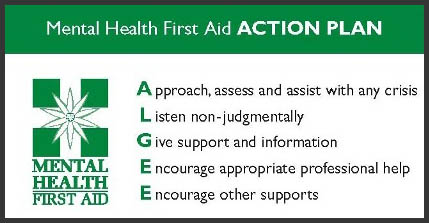Mental First Aid
A little while ago someone came through our doors asking for some help. She looked like she’d been roughed up, but was adamant that she didn’t want us to phone anyone for her or get medical help. All she wanted was to use the bathroom to clean up and, if we had any spare, some cash so that she could catch the bus.
Nothing we offered made a difference. She went to the bathroom, came out looking a little less disheveled, took the cash we offered, thanked us and left.
It freaked me out. A lot.
I felt that I should have been able to offer more, do more, help in some way – but had no idea how. It troubled me for weeks – still does, really. What also troubled me was that I had no tools to deal with how I felt about the event or how other people present at the time did. It was awkward and uncomfortable and I found it difficult to understand why I felt slightly guilty about the whole thing.
So when the opportunity arose for me to sign up for a course that would provide an overview of mental health issues and how a non-mental health professional can respond, I jumped at it.
The course is called Mental Health First Aid and it’s effectively the mental health equivalent of a standard first aid course. It was run over two days by the WA Association of Mental Health (WAAMH), who offered it at a significantly reduced cost – which was also a great incentive.
The course objective is to equip participants with the skills and resources to recognise and respond appropriately to someone experiencing a mental health crisis – at least until professional help arrives!
We covered a lot of ground, including:
- Understanding Mental Health, including diagnoses, prevalence and common misconceptions
- Symptoms and causes of depression, anxiety, psychosis and substance misuse.
- How to provide initial support to adults who are experiencing a mental health crisis.
- Crisis First Aid for: suicidal behaviour, panic attacks, aggressive behaviour, self harm, acute psychosis
- Responding to the effects of substance misuse
Some of it was heavy going, but it was made very real for all of us by the lived experience stories of people who came in to share those with us. Then there was the added dimension of about 60% of the course participants also having their own lived experiences of mental health issues, many of them still raw and relatively easily triggered. It made for some difficult situations and complicated conversations – but all of those served to inform each of us in different ways about how mental health can and does impact people’s lives.
I hadn’t realised that one in five Australians experience mental health issues, or that anxiety and depression are major players. And yet people don’t talk about it, don’t allow mental health to be just another health issue that can be managed. Why is that?
Perhaps part of it is fear. But if we don’t talk about the size and shape of the black dog (and his friend the elephant in the room), we won’t ever learn how to recognise it and learn how to manage it.
Having completed this very basic mental health first aid course, I feel slightly better equipped to answer some of the questions. I have facts, stats, a manual, an action plan and a certificate. These all make me feel safer.  But what really made a difference was talking to people, understanding a little better how to really listen, how best respond, what sort of help to offer, and where to find resources that can make a difference in a crisis situation.
But what really made a difference was talking to people, understanding a little better how to really listen, how best respond, what sort of help to offer, and where to find resources that can make a difference in a crisis situation.
I very much hope that if that young woman came back asking for our help again, I might just be able to do something useful for her without being quite so terrified that I’d be doing the wrong thing. And if she still only wanted to use the bathroom and get some bus fare… well, that’s okay too.